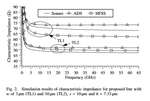Puppet123
Full Member level 6
Hello,
I am laying out am amplifier that operates around 100 GHz.
I want to EM simulate the interconnect of the transistors (metal stacks and vias) so I can capture the inductance, resistance and capacitance - my understanding is that the common extractors for parasitics do not capture the inductance properly, so I would like to EM simulate them.
My layout involves stacking many layers of metal (it is a silicon process, I am using the top metal of a 7-8 metal process as my signal metal) through many vias.
My question is: I was told that HFSS would be the way to do this due to its' 3D nature, but I am wondering whether Momentum would be adequate even though it might not capture the vias properly (I could use 3D via modeling with Momentum but it takes forever I find, maybe I am doing it wrong). Also would Momentum capture the skin effect properly at these frequencies ? Would the edge meshing be accurate - can or should I increase the meshing of the edge meshing ?
Does anyone have any thoughts or experience with these EM issues for the transistor layout parasitics due to interconnects especially over 60GHz ?
Was not sure whether this posting was best posted in this forum or the Analog IC Layout forum. I decided to post it here since it is more EM related.
Thank you.
I am laying out am amplifier that operates around 100 GHz.
I want to EM simulate the interconnect of the transistors (metal stacks and vias) so I can capture the inductance, resistance and capacitance - my understanding is that the common extractors for parasitics do not capture the inductance properly, so I would like to EM simulate them.
My layout involves stacking many layers of metal (it is a silicon process, I am using the top metal of a 7-8 metal process as my signal metal) through many vias.
My question is: I was told that HFSS would be the way to do this due to its' 3D nature, but I am wondering whether Momentum would be adequate even though it might not capture the vias properly (I could use 3D via modeling with Momentum but it takes forever I find, maybe I am doing it wrong). Also would Momentum capture the skin effect properly at these frequencies ? Would the edge meshing be accurate - can or should I increase the meshing of the edge meshing ?
Does anyone have any thoughts or experience with these EM issues for the transistor layout parasitics due to interconnects especially over 60GHz ?
Was not sure whether this posting was best posted in this forum or the Analog IC Layout forum. I decided to post it here since it is more EM related.
Thank you.
Last edited:



